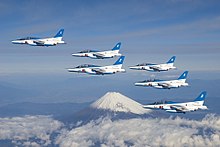
The USAF Air Demonstration Squadron ("Thunderbirds") is the air demonstration squadron of the United States Air Force (USAF). The Thunderbirds are assigned to the 57th Wing, and are based at Nellis Air Force Base, Nevada. Created 70 years ago in 1953, the USAF Thunderbirds are the third-oldest formal flying aerobatic team in the world, after the French Air Force Patrouille de France formed in 1931 and the United States Navy Blue Angels formed in 1946.

The Mitsubishi F-2 is a multirole fighter derived from the General Dynamics F-16 Fighting Falcon, and manufactured by Mitsubishi Heavy Industries and Lockheed Martin for the Japan Air Self-Defense Force, with a 60/40 split in manufacturing between Japan and the United States. The basis of the F-2's design is the F-16 Agile Falcon, an unsuccessful offer by General Dynamics to provide a low-cost alternative for the Advanced Tactical Fighter (ATF) competition. Production started in 1996 and the first aircraft entered service in 2000.
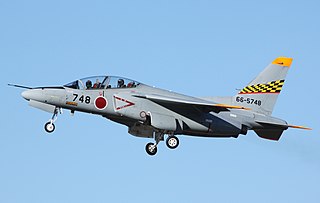
The Kawasaki T-4 is a Japanese subsonic intermediate jet trainer aircraft developed and manufactured by the commercial conglomerate Kawasaki Heavy Industries. Its sole operator is the Japan Air Self-Defense Force (JASDF), in part due to historic restrictions on the exporting of military hardware. In addition to its primary training mission, the T-4 has been used by the JASDF's Blue Impulse aerobatic team as well as liaison duties with most fighter units. The first XT-4 prototype flew on 29 July 1985, while the first production aircraft was delivered during September 1988.
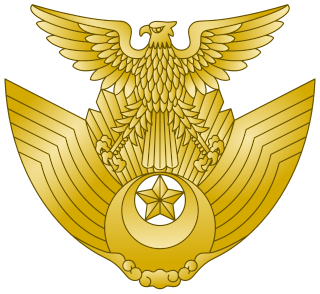
The Japan Air Self-Defense Force, JASDF, also referred to as the Japanese Air Force, is the air and space branch of the Japan Self-Defense Forces, responsible for the defense of Japanese airspace, other air and space operations, cyberwarfare and electronic warfare. The JASDF carries out combat air patrols around Japan, while also maintaining a network of ground and air early-warning radar systems. The branch also has an aerobatic team known as Blue Impulse and has provided air transport in UN peacekeeping missions.

All Nippon Airways (ANA) Flight 58 was a Japanese domestic flight from Sapporo to Tokyo, operated by All Nippon Airways (ANA). On 30 July 1971, at 02:04 local time, a Japan Air Self-Defense Force (JASDF) F-86F Sabre jet fighter collided with the Boeing 727 airliner operating the flight, causing both aircraft to crash. All 162 people aboard the airliner were killed, while the Sabre pilot, a trainee with the JASDF, freed himself from his airplane after the collision and parachuted to safety. This incident led to the resignation of both the head of Japan's Defense Agency and the JASDF chief of staff.

Antonio Marfori Bautista was an F-86 Sabre pilot who served in the Philippine Air Force. He served in the aerobatic display team the Blue Diamonds and fought against rebels in the south of the country. He was killed in action in January 1974.

The 53rd Air Demonstration Group, nicknamed the Black Eagles, is the flight display team of the Republic of Korea Air Force (ROKAF) based at Wonju, Gangwon Province.
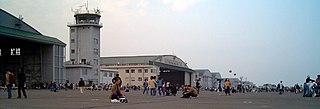
Iruma Air Base is a Japan Air Self-Defense Force (JASDF) base located in the city of Sayama, Saitama Prefecture, north of western Tokyo, Japan.

The PAF Blue Diamonds is the national aerobatic team of the Philippine Air Force (PAF). Assigned to the 5th Fighter Wing, the unit is based at Basa Air Base in Floridablanca, Pampanga. Founded in 1952, the Blue Diamonds is one of oldest formal flying aerobatic teams in the world, along with United States Air Force Thunderbirds founded in 1953, the United States Navy Blue Angels formed in 1946, and the Patrouille de France of the French Air Force formed in 1931. The Blue Diamonds has been inactive since 2005.

Hamamatsu Air Base is a Japan Air Self-Defense Force base located 3.0 NM north of the city of Hamamatsu, Shizuoka Prefecture, in central Japan.

JASDF Matsushima Air Base is a military aerodrome of the Japan Air Self-Defense Force located in Higashimatsushima, 6.6 NM west of Ishinomaki in the Miyagi Prefecture, Japan. Headquarters for the 4th Air Wing (JASDF), the base is primarily used for training, and is the home of the JASDF 21st Fighter Training Squadron, currently equipped with Mitsubishi F-2B fighters. It is also the home base for the "Blue Impulse" JASDF acrobatic display team.

The 501st Tactical Reconnaissance Squadron was a squadron of the Japan Air Self-Defense Force based at Hyakuri Air Base in Ibaraki Prefecture, Japan. It was equipped with RF-4 Phantom II and Kawasaki T-4 aircraft.
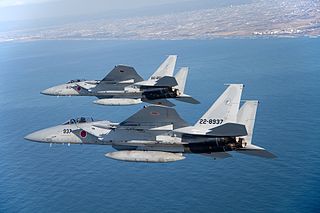
Fighter units of the Japan Air Self-Defense Force are squadrons of fighter aircraft dedicated to the defense of Japan. As Article 9 of the Japanese Constitution states that the country renounces war, JASDF fighter squadrons have never been deployed in combat overseas.

The 3rd Tactical Fighter Squadron is a squadron of the 7th Air Wing of the Japan Air Self-Defense Force (JASDF) based at Hyakuri Air Base, in Ibaraki Prefecture, Japan. It is equipped with Mitsubishi F-2 and Kawasaki T-4 aircraft.

The 305th Tactical Fighter Squadron is a squadron of the 5th Air Wing of the Japan Air Self-Defense Force based at Nyutabaru Air Base, in Miyazaki Prefecture, Japan. It is equipped with Mitsubishi F-15J and Kawasaki T-4 aircraft.

The 303rd Tactical Fighter Squadron is a squadron of the 6th Air Wing of the Japan Air Self-Defense Force (JSDF) based at Komatsu Air Base, in Ishikawa Prefecture, Japan. It is equipped with Mitsubishi F-15J/DJ and Kawasaki T-4 aircraft.
The 2nd Squadron was a squadron of the 1st Air Wing of the Japan Air Self-Defense Force based at Hamamatsu Air Base, in Shizuoka Prefecture, Japan. It was equipped with North American F-86F Sabre aircraft.
The 5th Squadron was a squadron of the 4th Air Wing of the Japan Air Self-Defense Force based at Matsushima Air Base, in Iwate Prefecture, Japan. It was equipped with North American F-86F Sabre aircraft.

The 21st Fighter Training Squadron is a squadron of the 4th Air Wing of Air Training Command of the Japan Air Self-Defense Force. It is based at Matsushima Air Base in Miyagi Prefecture, Japan.

The Air Rescue Wing is a wing of the Japan Air Self-Defense Force. Responsible for airborne search and rescue, it is headquartered at Iruma Air Base in Saitama Prefecture and controls squadrons and detachments across Japan. The helicopter airlift squadrons were previously under the authority of Air Support Command. It is equipped with CH-47J, UH-60J and U-125A aircraft.



